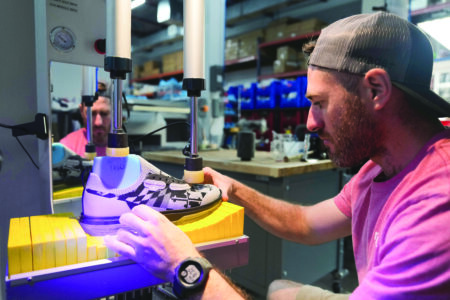STEM processes: Awesome for all

Jan Sabin, Mary Davis, Jean Hetrick, Cheryl Anderegg, Esther Macalady, Colleen Walker, Fran Darling and Iris Katers. (Journal photo)
“Accept the challenge so that you can feel the exhilaration of victory.” George S. Patton
When we talk the challenging language of STEM: science, technology, engineering, math plus art with our children, we give them the power and confidence to solve problems for themselves.
Talking the Talk
STEM is a process that can help children their entire life. Step one: Ask what is the problem that needs to be solved? Two: What are some ways to solve the problem? Three: What is the best way to solve the problem? Four: Make a plan to solve the problem. What is the way to go about the solution? What materials do we need? Let’s draw a picture. Five: Create. Let’s do it! Six: Test it! Does it work? Do we like the result? Seven: Can we make it better? Improve and retest. Eight: Let’s show and explain it to others, unless it is a secret. Whether solving in a group or all by yourself, the steps are the same.
Walking the Walk
Here is a problem and a way a child may walk through the STEM processes. One: How can I decorate the spokes of my bicycle or tricycle? Two: What colors and materials do I want? Do I decorate the spokes or the whole thing? Three: I (We) decide to do spoke weaving. Four: Make some drawings. I will use crepe paper ribbon and yarn and tie and tape them on the spokes. Five: Let’s do it.! Turn the tricycle on its side so the big wheel turns freely. Weave the crepe paper or ribbons in the spokes. Six: Test it. Spin the wheels. It’s good. Seven: Can I make it cooler? Can I use two primary colors like yellow and blue to make green if I spin it fast? Can I decorate the small wheels? Try out the bike. What else can I do? Are there some old silk flowers or shiny Fourth of July decorations around to make it better? Could crepe paper be wound around the handle bars and the body of the bike? Does Grandpa remember how to put a playing card held with a clothes pin on the wheel to make a noise? Eight: Let’s show someone.
The Principle
What is the science principle? The decorated wheel on the tricycle or bicycle can spin very rapidly. The human eye can’t keep up with the speeding images so the brain blends the colors together into a blur of moving, mixing colors and shapes. As the spinning wheel slows down, the eye can begin to see separate decoration and individual colors. The blending may only happen when the trike is spun manually rather than riding.
For more, see grandparentsteachtoo.blogspot.com and wnmufm.org/Learning Through the Seasons since 2009, live and pod casts during NPR news; Facebook, and Pinterest since 2009.
EDITOR’S NOTE: Grandparents Teach, Too is a non-profit organization of elementary and preschool teachers from Marquette, Michigan. The writers include: Jan Sabin, Mary Davis, Jean Hetrick, Cheryl Anderegg, Esther Macalady, Colleen Walker, Fran Darling, and Iris Katers. Their mission since 2009 is to help parents, grandparents, and other caregivers of young children provide fun activities to help prepare young children for school and a life long love of learning. They are supported by Great Start, Parent Awareness of Michigan, the U.P. Association for the Education of Young Children, Northern Michigan School of Education, the Upper Peninsula Children’s Museum and the Northern Michigan University Center for Economic Education.





